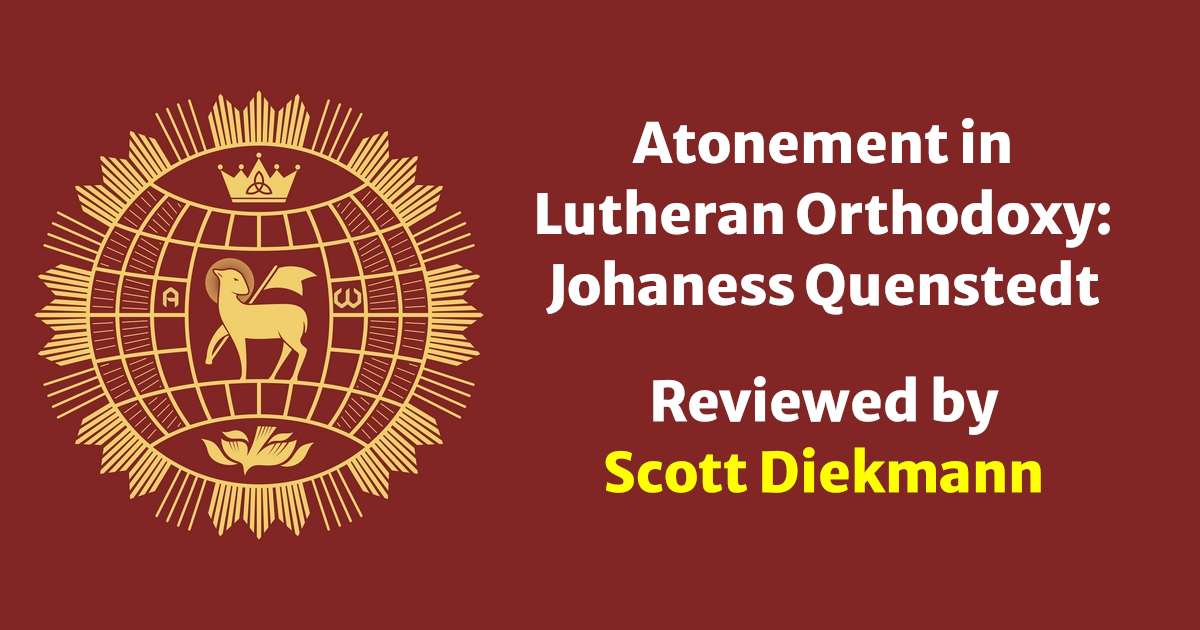Copyright (c) 2023 Scott Diekmann. Used by Permission.
Note: This review may be downloaded in a PDF here.
Candles flicker and floorboards creak against rusty nails at Wittenberg University in 1685. Johannes Quenstedt deliberates at his desk, toiling to get the words just right. His quill moves in fits and spurts as black carbon ink intermittently flows across the page. The last of the great Lutheran theologians of the Age of Orthodoxy is finishing up his magnum opus, Theologia Didactico-Polemica Sive Systema Theologicum. His soon to be printed two-volume masterpiece will mean extra income for him and his large family. His work will also mean uncounted blessings for his theological descendants.
Like the Book of the Law in 2 Kings 22, Quenstedt’s work has largely sat gathering dust on the shelves of European libraries, unheeded due to our deteriorating language skills, our deteriorating thinking skills, and in some cases, our aversion to sound theology. The book that is the subject of our review, Atonement in Lutheran Orthodoxy: Johannes Quenstedt (hereafter referred to as Atonement), seeks to remedy those woes.

Atonement contains the first translation into English of the subsection on Christ’s priestly office contained in Theologia Didactico-Polemica Sive Systema Theologicum (translated Didactic-Polemical Theology, Or a Theological System; hereafter Systema). Also included is a foreword by Burnell F. Eckardt, Jr., a biographical introduction of Quenstedt by Jack D. Kilcrease, a preface from the publisher, T. R. Halvorson, an essay by Robert D. Preus titled “The Vicarious Atonement in John Quenstedt,” and a very helpful and comprehensive bibliography. The translator, Matthew Carver, is a well-known Lutheran who has translated many projects for Concordia Publishing House, including the three-volume set The Great Works of God by Valerius Herberger.
Johannes Quenstedt was a master of Lutheran scholasticism (which is not to be confused with the earlier problematic medieval scholasticism). Through a series of theses and observations Quenstedt uses philosophical categories and careful exegesis to defend the theology of the Reformation and explain it in a clear and thorough way.[1] Robert D. Preus says that Quenstedt’s theology was done “with a lucidity that defies misunderstanding,” and that after Chemnitz and Gerhard, “Quenstedt ranks as the greatest dogmatics book ever written by a Lutheran.”[2] While the occasional use of Greek, Latin, and Hebrew in the book might seem daunting to the layman, that should not be the case. The foreign languages are frequently translated and are not an obstacle to overall understanding. Nor should the philosophical terminology be a hurdle, which in this section of Systema is minimal.[3]
In the foreword of the book, Burnell F. Eckardt, Jr. affirms:

The doctrine of the atonement–which is at the heart of the priestly office of Christ–ought never be taken for granted, and it falls to the faithful of every generation to study and proclaim the atonement and its true meaning. It’s not enough–it’s never enough–for any generation of Lutherans, however faithful they may think themselves to be, to assume that their own due diligence has already been done. The doctrine of the Gospel in all its articles must be taught, and never assumed to be rightly understood merely from the cursory hearing of what we may think its watchwords to be. Central to the Gospel is the doctrine of the priestly office of Christ and His atoning sacrifice, which in particular must therefore be taught, unpacked, understood, and stubbornly defended.[4]
Those words ring entirely true. This book is a very timely contribution, because Quenstedt indeed unpacks the theology of the atonement, teaching Christ’s vicarious satisfaction for our sins, and defending the selfsame doctrine. His defense is our defense, and a defense is indeed needed. While the teaching of the atonement in all its facets is entirely clear in

Holy Scripture (as Quenstedt so wonderfully demonstrates), there are those even today who reject the atonement, proclaiming that God forgives sinners by divine fiat without Christ’s satisfaction, which can subsequently lead to antinomianism and a confusion of Law and Gospel. This type of thought most recently stems from Gerhard Forde and his “radical Lutheranism.”[5] Forde fought against the theological relativism of his day in the Evangelical Lutheran Church in America, certainly a laudable and timely goal, but in the process erred in significant ways.[6] The danger in his thinking is that we lose Christ’s salvific benefit, and the certainty of our salvation. We no longer have the sure promise of Christ that our sins are forgiven for His sake.[7] Our justification is no longer accomplished by Christ at the cross and the empty tomb, but rather solely through proclamation from the lips of your pastor, creating saving faith. (It is true that justification is delivered through the means of grace, which includes preaching, yet it is previously accomplished by Christ–justification without Christ’s vicarious satisfaction is not justifying.)[8] Now, we must look to ourselves and our faith for certainty, not unlike the uncertainty found in Calvinism and Roman Catholicism. To put it into Lutheran terms, extra nos becomes intra nos, and objective justification dies. Along with antinomianism comes a corresponding deemphasis on sanctification. John F. Brug sums Forde up: “…A defective presentation of justification and a defective presentation of sanctification are natural, almost inevitable, companions. Antinomianism is the fraternal twin of antigospelism.”[9] Radical Lutheranism may seem distant to the average Lutheran pew sitter, but it’s ideas are promulgated in materials published by synod institutions, parachurch organizations, and the occasional festschrift that finds its way to your pastor’s desk. With these things in mind, it is no surprise that Eckardt describes Quenstedt’s work as “an invaluable tool needed against a new generation of theologians who address the atonement in our day with flawed reasoning while showing lip-service to the Scriptures.”[10]

Like John the Baptist in Grünewald’s Isenheim Altarpiece, in Atonement Quenstedt points us to Christ and His work on the cross as our High Priest. Chapter One begins with Quenstedt’s Thesis XIV:
The priestly office is the function of Christ the θεάνθρωπος [God-Man] whereby He, for our sake, in our place, and for our good, according to the eternal counsel of God and the promise made by Himself subjected Himself in time to the Law of God, and by the perfect fulfillment and suffering of all punishment rendered the obedience entirely satisfying to divine righteousness, and delivered us from the wrath of God, the curse of the Law, and from sin and all evils, which obedience He shows even now to God the Father and by His own intercession prays for every good needful to us.[11]
Unlike many of the Theses, where Quenstedt makes multiple observations in outline form, this one is free-standing. It is a beautiful summary of Christ’s priestly office and the atonement, and a steadfast presentation of Lutheran orthodoxy–yet it already begins to run afoul of radical Lutheranism. Certainly Gerhard Forde would object to the notion that Christ would satisfy God’s wrath in our place according to the eternal counsel of God. Au contraire, Forde asks the rhetorical question “Why should a God who is by nature merciful demand satisfaction?”[12] And his answer is, He doesn’t.[13] According to Forde, “Jesus dies for us and not for God. There is not just a little perversity in the tendency to say that the sacrifice was demanded by God to placate the divine wrath.”[14] “If the death was payment, how could reconciliation be an act of mercy?”[15] Quenstedt answers his question in Thesis XLI:

The end of the satisfaction on the part of God is the demonstration of (1) divine righteousness, for God willed not to forgive us any sins without satisfaction in order that He might demonstrate to us His righteousness; (2) mercy, φιλανθρωπιία, which is apparent in the fact that God the Father handed over His only begotten Son to the most shameful death in our place and accepted His satisfaction for us, and that the Son freely took upon Himself our sins and atoned for them by His death.[16]
Radical Lutherans claim that the Law always accuses, which is correct, but they also claim that the Law only accuses, which is incorrect. Since they deem that the Law is not of God’s essence, the creature of the new Aeon has no use for the Law, including the third use of the Law. Steven D. Paulson, a former student of Forde, states that “the delight the baptized take in the law is in fact that law is finally past.”[17] He also thinks “There is no eternal law in the new creation, or any continuation, fulfillment, completion, or perfection of law–Spirit means no law at all in the new life.”[18] Compare that with Johannes Quenstedt:
Matthew 5:17: “Do not think that I came to destroy the Law or the Prophets. I did not come to destroy but to fulfill.”
Observation. Καταλῦσις of the Law is contrasted to the πληρῶσις of the Law by the force of the words. But the καταλῦσις of the Law is not only the violation and transgression thereof, but also the destruction and abolition, for καταλῦσις is more than violating. To destroy [dissolvere] the Law is to abolish, overturn, rescind, and destroy it (Gal. 2:18), while πληρῶσις is the observance, perfection, and consummation thereof. Therefore Christ says truly that He came not to καταλῦσαι τὸν νόμον, or to overturn, destroy, and rescind the Law, or to pervert it by changing its true sense, by abolishing its purpose, or by rendering it ineffectual, but to fulfill, perfect, and consummate it.[19]
The two views could not be more different.
Paulson opines that
…the precise receiver of the sacrifice of the cross has been unclear…. Forde suggested we think of Christ’s crucifixion as an accident like those stories of someone “stepping in and taking the blow of an oncoming truck while throwing an endangered child to safety. That is a “sacrifice” of life, as even our common language says, but not in the form of a temple sacrifice. So Christ could rightly be said to have died for our sakes, without attempting to explain the cross as something the law required, or even something that God needed for his own purity’s sake. The accident of Christ’s death was caused by us sinners who, like the truck driver, are determined to get to our highest goal at whatever speed necessary, even at the cost of the neighbor’s life.[20], [21]
His words deny Christ’s vicarious satisfaction. Quenstedt corrects:
And as Christ acquired for us not imaginary but true blessing and righteousness, so He underwent for us not imaginary but true execration. Neither was Christ made for us an execration by some occasion or chance or fortuitously, as if by accident He fell upon some execration because of us, as Socinus… wishes, but by divine arrangement, direction, and counsel. Hence in Luke 22:22, the Savior says that He is going to the death of the cross κατὰ τὸ ὡρισμένον, “as it has been determined.” And in Acts 2:23, Peter says that Jesus was delivered over by the ὡρισμένῃ βουλῇ, “the determined purpose and foreknowledge of God.”[22]
These brief examples, while certainly not a comprehensive look at radical Lutheranism, serve to illustrate the utility of Quenstedt’s Atonement in countering erroneous aspects of radical Lutheran beliefs, who have little use for the theologians of the Age of Orthodoxy. Perhaps their low view of Lutheran scholasticism comes from a corresponding low view of Holy Scripture. Paulson says of the Lutheran scholasticism exemplified by Gerhard and Quenstedt: “…Fear of the consequences of preaching the law’s absolute end prompted an attempt at a universal, allegorical interpretation of God’s order or plan as an eternal law into which Christ’s cross could be fit.”[23] “Whether one makes faith a cause of justification or an effect of it, the heart of Christ and the preacher’s word are removed so that only a carcass remains.”[24] His words are hardly fitting for the likes of Gerhard and Quenstedt, as Atonement clearly proves. Burnell F. Eckardt, Jr.’s comments in the foreword are insightful, especially considering the title of his doctoral dissertation, “Anselm and Luther on the atonement: Was it ‘necessary’ ?” He warns that the heirs of Gustaf Aulén, which would include the radical Lutherans, “whose errors, when taken to their logical conclusions, ultimately dispatch the need for the atonement altogether.”[25]

Contra the radical Lutherans, Robert D. Preus tells us in his 1961 essay “The Vicarious Atonement in John Quenstedt” in Chapter Two of Atonement that “the old Lutheran theologians offer something which is remarkably well balanced and solidly Scriptural.”[26] He provides an antecedent synopsis for the book, as well as a prescient commentary. Preus summarizes:
This study of a typical Orthodox Lutheran discussion of the doctrine of the vicarious atonement will, I hope, serve to show us two things: first, how much we today owe to the orthodox Lutheran theologians for the theology which has been handed down to us, and second, how we can still learn from their careful, Scriptural treatment of all doctrine.[27]
From a practical standpoint, Atonement is nicely bound and laid out, esthetically pleasing, and as inexpensive a book as you’ll ever find. In short, it is a rare gem waiting to be read by those who want to learn about and defend the atonement. Jack Kilcrease perfectly sums up Quenstedt when he says in the biographical introduction that “he was a man of deep faith and impeccable orthodoxy.”[28] Johannes Quenstedt, like John the Baptist before him, points us to our Savior Jesus Christ, who is the propitiation for our sins, and not for ours only but also for the sins of the whole world. “Therefore our wickedness and iniquities thoroughly crushed our sweetest Jesus and as it were pressed out in the winepress the blood of this most noble Cluster for the satisfaction of the heavenly Father and for our healing.”[29]
[1] Another example of Lutheran scholasticism can be found in Luther’s Works, volume 73, Disputations II, which exhibits a typical form of scholastic debate.
[2] Robert D. Preus, The Theology of Post-Reformation Lutheranism: A Study of Theological Prolegomena (St. Louis: Concordia Publishing House, 1970), 62.
[3] Robert D. Preus, “The Doctrine Of Election As Taught By The Seventeenth Century LutheranDogmaticians,” Theologische Quartalschrift 55, no. 4 (1958): 229–261. Not all portions of Systema are so easily followed. Preus mentions, for instance, that Quenstedt’s discussion of the causes of election, located elsewhere in Systema, “becomes quite complicated… and many do not follow it.” However, Quenstedt’s difficult discussion in one point does not mean that we should therefore take an anti-doctrinal stance, or deride what he has to say. He remains an exemplar of orthodox Lutheran theology.
[4] Burnell F. Eckardt, Jr., foreword to Atonement in Lutheran Orthodoxy: Johannes Quenstedt (Sidney, MT: Synoptic Text Information Services, Inc., 2023), v.
[5] The moniker “radical Lutheranism” stems from Forde’s 1987 article in Lutheran Quarterly titled “Radical Lutheranism.” Others who have followed in Forde’s path include Oswald Bayer, Carl E. Braaten, Nicholas Hopman, Mark C. Mattes, James Nestigen, Steven D. Paulson, and Timothy Wengert.
[6] Jack D. Kilcrease, The Doctrine of Atonement: From Luther to Forde (Eugene: Wipf & Stock, 2018), 116, 118; David P. Scaer, “Is Law Intrinsic to God’s Essence?,” Concordia Theological Quarterly 82, nos. 1-2 (2018): 8. Regarding antinomianism, Jack Kilcrease believes that “As a result of his view of atonement, Forde significantly reshapes how the practice of preaching law and gospel should take place. A direct reassertion of the law by Christ would not disrupt the previous existential situation under the law, but rather prolong it. Nevertheless, if preaching is discontinuous with the law, we necessarily fall into a kind of antinomianism, something that Forde also wishes to avoid.” His “attempt at staving off antinomianism brings him uncomfortably close to the pastoral practice of the early Lutheran heretic Johann Agricola… [who] came to the conclusion in the mid-1520s that, since only faith could bring about works of love, and because true, heartfelt contrition was a work of love, only persons who had faith already could truly repent. Therefore, Agricola also concluded that since faith came from the gospel, only the preaching of the gospel could bring about true repentance. For this reason, only the gospel and not the law should be preached.” David P. Scaer holds that the “soft antinomianism” of radical Lutherans “comes across as benign, but any denial of the third use [of the Law], small or catastrophic, is symptomatic of a structural flaw in how God, Christ, and the atonement are understood and corrupts the entire theological enterprise.”
[7] Concordia: The Lutheran Confessions, ed. Paul Timothy McCain (St. Louis: CPH, 2006), 228. Formula of Concord, Solid Declaration III, 15 reads: “…His obedience (not only in His suffering and dying, but also because He was voluntarily made under the Law in our place and fulfilled the Law by this obedience) is credited to us for righteousness. So, because of this complete obedience, which He rendered to His heavenly Father for us by doing and suffering and in living and dying, God forgives our sins. He regards us as godly and righteous, and He eternally saves us.” (Emphasis added.)
[8] Francis Pieper, Christian Dogmatics, 3 vols. (St. Louis: Concordia Publishing House, 1950-1953), 2:350. Pieper reasons “Where the objective reconciliation is denied, the Gospel can no longer be ‘the Word of Reconciliation’ (2 Cor. 5:19), ‘the Word of His grace’ (Acts 20:32)….”
[9] Brug, John F., “The Lutheran Doctrine Of Sanctification And Its Rivals” (lecture, WELS North Atlantic District Conference, June 15, 1993).
[10] Eckardt, foreword to Atonement, vii.
[11] Johannes Quenstedt, “Of the Priestly Office,” in Atonement in Lutheran Orthodoxy: Johannes Quenstedt (Sidney, MT: Synoptic Text Information Services, Inc., 2023), 2.
[12] Gerhard O. Forde, “Caught in the Act: Reflections on the Work of Christ,” Word & World 3, no. 1 (1983): 25.
[13] Forde, “Caught in the Act,” 26. Forde’s exact words: “Why could not God just up and forgive? Let us start there. If we look at the narrative about Jesus, the actual events themselves, the ‘brute facts’ as they have come down to us, the answer is quite simple. He did!”
[14] Gerhard O. Forde, “The Work of Christ,” in Christian Dogmatics, 2 vols., eds. Carl E. Braaten and Robert W. Jenson (Philadelphia: Fortress Press, 1984), 2:82.
[15] Forde, “Caught in the Act,” 23.
[16] Quenstedt, “Of the Priestly Office,” 77-78.
[17] Steven D. Paulson, Lutheran Theology (New York: Bloomsbury, 2011), 184.
[18] Paulson, Lutheran Theology, 202.
[19] Quenstedt, “Of the Priestly Office,” 69.
[20] Paulson, Lutheran Theology, 233.
[21] Paulson, Lutheran Theology, 233; Quenstedt, “Of the Priestly Office,” 17. The full text of the first portion of the quote reads “Even Christ’s own sacrifice is revealed as non-cultic, since from the beginning the precise receiver of the sacrifice of the cross has been unclear: did the Father need to receive Christ’s sacrifice in order to cease his wrath? Did the law–or perhaps Satan–require payment? Was it done instead of our failed sacrifices? Was Christ’s sacrifice really once and for all, or only for those sins up to that time?” Quenstedt furnishes the answer in Thesis XXVI: “The satisfaction was made to the Triune God and to His righteousness; it was not made to us, though certainly for us.”
[22] Quenstedt, “Of the Priestly Office,” 37.
[23] Paulson, Lutheran Theology, 11.
[24] Paulson, Lutheran Theology, 60.
[25] Eckardt, foreword to Atonement, vii.
[26] Robert D. Preus, “The Vicarious Atonement in John Quenstedt,” in Atonement in Lutheran Orthodoxy: Johannes Quenstedt (Sidney, MT: Synoptic Text Information Services, Inc., 2023), 94.
[27] Robert D. Preus, “The Vicarious Atonement,” 95.
[28] Jack D. Kilcrease, biographical introduction to Atonement in Lutheran Orthodoxy: Johannes Quenstedt (Sidney, MT: Synoptic Text Information Services, Inc., 2023), xviii.
[29] Quenstedt, “Of the Priestly Office,” 27.




